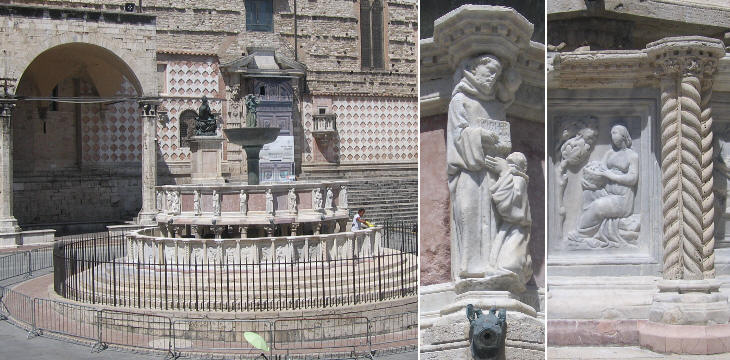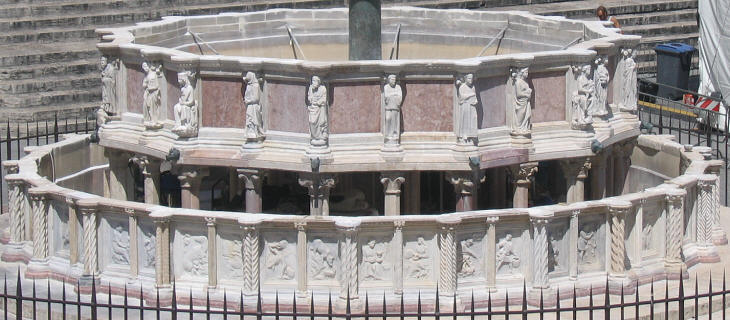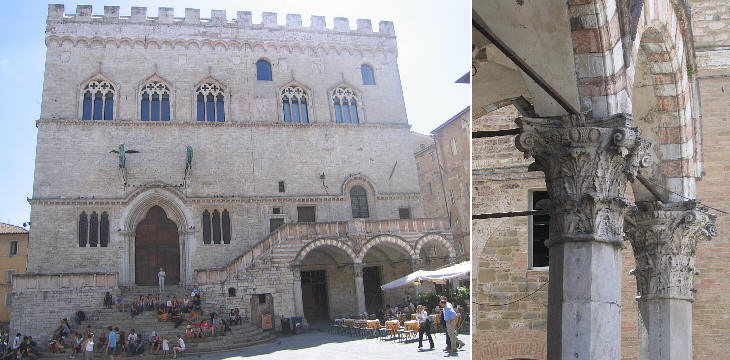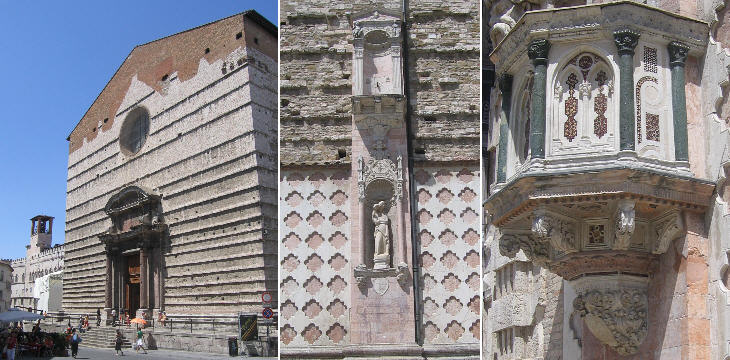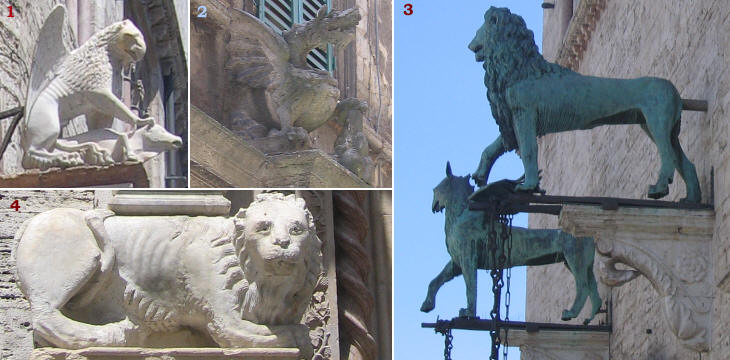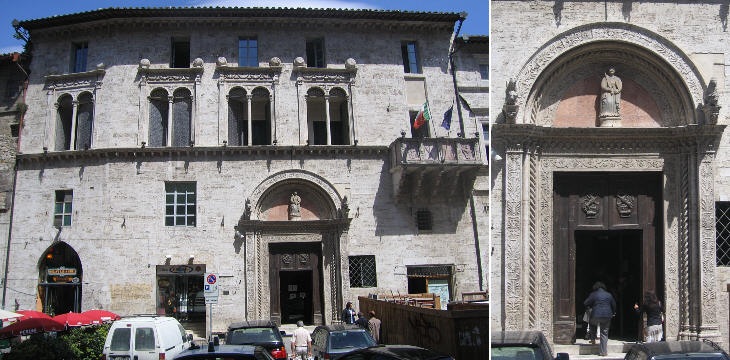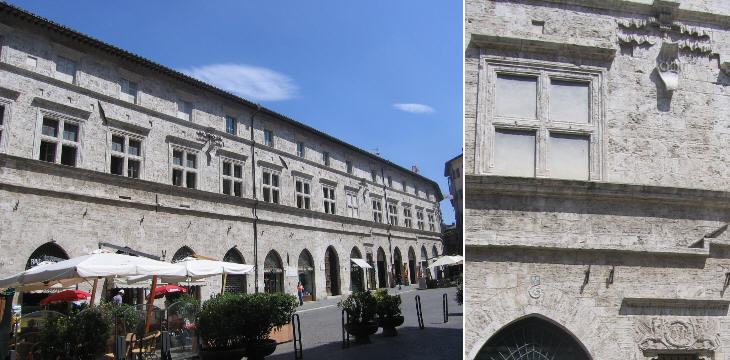  What's New! Detailed Sitemap All images © by Roberto Piperno, owner of the domain. Write to romapip@quipo.it. Text edited by Rosamie Moore. Page added in July 2007. |
Everyday a train leaves Termini at 8:14; first stop: Orte; second stop Narni; third stop Terni; fourth stop Spoleto; fifth stop Trevi; sixth stop Foligno; seventh stop Spello; eighth stop Assisi; last stop ... 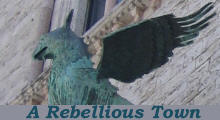 Perugia - part two: the main squares Perugia - part two: the main squares
The citizens of the Italian town states which flourished in Northern and Central Italy after the year 1000 had often conflicting views on how their communities should be ruled. However they always agreed on one thing, regardless of their political opinions and economic interests: they always supported the embellishment of their towns.
A grand central piazza was often seen as the symbol of the importance acquired by an Italian town: in many cases a large fountain was a later addition meant to embellish the site. On the contrary Fontana Maggiore in Perugia was the first element of what was to become one of the finest Italian piazzas. In the XIIIth century the town relied on the water taken from some ancient wells: between 1254 and 1276 the municipal authorities built an aqueduct to provide Perugia with an ample supply of fresh water and in 1275 they decided to celebrate its completion by erecting a large fountain.
Perugia commissioned the fountain to Nicola Pisano, who had acquired great fame as both an architect and a sculptor by his works in Pisa (hence his "family name") and Siena. He worked for three years with the assistance of his son Giovanni: the harmonious design of their fountain is an anticipation of the Renaissance and the very rich decoration moves away from the traditional medieval iconography: it is worthwhile mentioning in detail the subjects of the reliefs and of the statues: the lower ring of the fountain is divided into 24 panels and each panel has two reliefs: a) panels 1-12 show the months of the year and the corresponding zodiacal signs; b) panel 13 shows the symbols of Perugia: the Guelph lion and the griffin; c) panels 14-17 show the seven liberal arts and Philosophy; d) panel 18 is decorated with two eagles; e) panel 19 shows Adam and Eve and their banishment from Eden; f) panel 20 shows episodes of Samson's life; g) panel 21 is decorated with lions; g) panel 22 shows episodes of David's life; h) panel 23 shows episodes of the life of Romulus and Remus; i) panel 24 shows two fables by Aesop. The upper ring was decorated with plain pink panels inserted in white frames, a tribute to the local tradition of utilizing the red stone of Monte Subasio near Assisi; Giovanni Pisano placed between the panels 24 statues portraying saints, biblical and mythological characters and two members of Perugia's government system: Matteo da Correggio, the acting podestÓ (a magistrate who ruled an Italian town in the XIIIth century; usually he was a foreigner and held the position for only a short period) and Ermanno da Sassoferrato, the acting Capitano del Popolo, the leader of the representatives (Priori) of the municipal guilds. This vast iconography shows the varied interests of an affluent and peaceful society.
The piazza became known as Piazza della Fonte and only at a later time it was called Piazza del Duomo: today the official name is Piazza IV Novembre 1918 (the day WWI ended in Italy). Soon after the completion of the fountain the municipal authorities decided to build on the southern side of the piazza Palazzo dei Priori, a new town hall named after the magistrates who assisted Capitano del Popolo. On the right side of the fašade a balcony above an elegant loggia was used to make public announcements.
Palazzo dei Priori had a fašade also along the main street of Perugia: this side of the palace was enlarged several times and in 1346 it was embellished by an elaborate portal.
A church closed the piazza on its northern side, but the inhabitants of Perugia felt its size and decoration was no longer appropriate for their town. The decision to build a new cathedral was taken at the beginning of the XIVth century, but work started only in 1345, just a few years before the fortunes of Perugia started to decline: in 1348 the pestilence known as the Black Death greatly reduced its population and a few years later Cardinal Gil de Albornoz restored papal authority in the region. Although Perugia maintained many of its privileges and some sort of self-government it could not devote to the construction of the cathedral the resources required by the initial ambitious plan. The building was not completed until 1490 and the elegant white and pink decoration covered only part of the southern side which was also embellished by a very fine pulpit.
The lion was the symbol of the Guelph party which supported the papacy: during the XIIIth century Perugia was very loyal to the popes and the cardinals often found it safer to hold their conclaves in Perugia rather than in Rome: so Pope Honorius III, Pope Clement IV Pope Honorius IV, Pope Celestine V and Pope Clement V were all elected in Perugia. The griffin, a mythical creature, is the symbol of Perugia and obviously it is seen on many buildings: the statue of the griffin in the act of killing a calf was placed on the portal of Palazzo dei Priori by the butchers' guild of the town.
A short street leads from Piazza IV Novembre to another very interesting square (today it is called Piazza Matteotti) which was mainly developed during the XVth century: the role of the Capitano del Popolo at that time was that of a magistrate and the palace built in 1473-81 was used to house some of the tribunals: legislation was very complex for the overlapping of state, municipal and religious jurisdictions and so there were several different judicial institutions. The statue above the entrance portrays Justice holding a sword.
The ancient name of the piazza was sopramuro (above the wall) because its eastern side was next to the old walls: it was the site of several markets and the very long palace shown above was initially built (mid XVth century) to obtain a series of shops. Pope Sixtus IV (1471-84) commissioned the construction above the shops of a new centre for the local university. Its windows are similar to those of Palazzo Venezia in Rome. Move to part three: walking about. 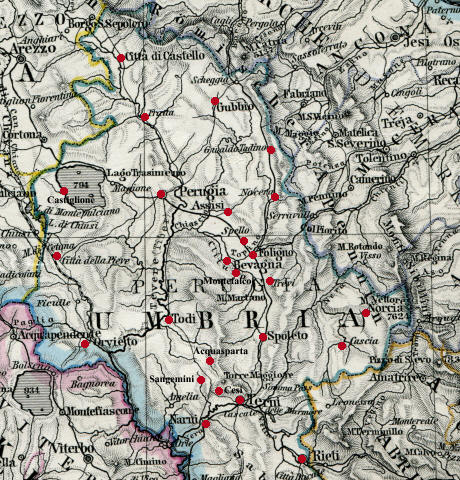
1864 clickable map of Umbria |
